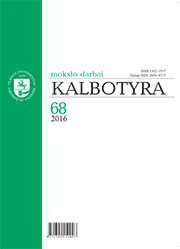Mažosios baltų kalbos?
Minor Baltic languages?
Author(s): Vytautas KardelisSubject(s): Morphology, Pragmatics, Historical Linguistics, Sociolinguistics, Baltic Languages
Published by: Vilniaus Universiteto Leidykla
Keywords: minor Baltic languages; Yatvingians; Curonians; Semigallians; Selonians; dialectology; onomastics; substratum; typophobia; typophilia; dialectometrics;
Summary/Abstract: The present study deals with the identification of minor Baltic languages, namely Yatvingian, Curonian, Semigallian and Selonian. Although this question has received much attention in traditional Baltic studies, close analysis of the empirical data shows that the criteria for distinguishing these languages should be reconsidered. The present study revises the traditional classification of the minor Baltic languages and verifies hypotheses raised in the most important works by Būga (1958–1961), Dini (2000; 2014), Kabelka (1982), Karaliūnas (2015), Mažiulis (1994), Salys (1995), Zinkevičius (1984) and the Encyclopedia of the Lithuanian Language (2008). The question arises whether the minor Baltic languages could be distinguished on the basis of features discussed in the literature. Thorough analysis of their distinctive features and the prominence of the latter (see Figure 7) show absence of reliable linguistic data and clear arguments which would allow us to make a distinction between Yatvingian, Curonian, Semigallian and Selonian. The present study verifies the role of historical regions, place names and Lithuanian dialects in distinguishing these languages. Historical regions are not a reliable criterion because some Baltic tribes and areas had apparently independent languages, while other tribes and areas did not. Similarly, place names, recorded in Lithuanian and Latvian subdialects, cannot be regarded as a reliable criterion because the linguistic evidence they provide for the identity of these languages is insufficient. Individual place names should be thoroughly analyzed on the basis of archeological, historical, sociolinguistic and migration data, though these data may be difficult to obtain. The features of Lithuanian dialects and their geography, which should also be considered from a typological perspective, unfold from the substratum theory of the minor Baltic “languages”. Revision of the traditional classification of the minor Baltic languages yields paradoxical results. Firstly, distinguishing these languages on the basis of phonetic features, which turn out to be unreliable, seems to be inadequate. Secondly, today Lithuanian Baltic studies tend to emphasize the archaic character of the Baltic languages, which naturally implies stability, slow change, etc. However, emphasis on the archaic character of the Baltic languages implies not only differentiation of the minor Baltic languages but also considerable differentiation of the Lithuanian dialects (see Zinkevičius 1984, 9; 2006, 17). The results obtained are clearly contradictory. Analysis of the minor Baltic “languages” should combine both typophobic and typophilial1 approach. The former identifies differences and explores individual features, whereas the latter identifies similarities, establishes relations between entities and draws generalizations. Typophilial approach unavoidably leads to the typological research into Lithuanian and Latvian, the surviving Baltic languages. Both approaches may raise a hypothesis that the Baltic area is probably homogenous rather than divergent. The archaic character of the Baltic languages and their relatively slow change may be the result of their slight internal differentiation. Typophobic and typophilial approaches may be combined with dialectometrics, an effective method of analysis, which has not been applied in Lithuanian linguistics yet. The approaches and methods mentioned above could benefit both minor and major Baltic languages and their history.
Journal: Kalbotyra
- Issue Year: 2016
- Issue No: 68
- Page Range: 42-66
- Page Count: 25
- Language: Lithuanian

